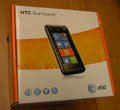Hands-on with the HTC Surround and Samsung Focus WP7 smartphones

I have been using Windows Phone 7 since July and over the past week I have been using the AT&T HTC Surround and Samsung Focus retail release devices. I also had the chance to try out the LG Quantum, Dell Venue Pro, and HTC HD7 for a few minutes each. The operating system has not changed too much from the Technical Preview version I looked at in depth so it was easy to pick up and use these retail devices. I embedded video walk throughs of the HTC Surround and Samsung Focus, photo gallery of product photos and screenshots, and included more thoughts on the hardware and software. Stay tuned for follow-up posts on 3rd party apps, text input, and Mac synchronization.
| Image Gallery: Visit this gallery for photos of the HTC Surround and Samsung Focus, along with a few screenshots. |  | |||||
What's new in the retail release of Windows Phone 7?
I recommend you check out all of my videos and coverage of the software in the Tech Preview Guide. Looking at the previous Technical Preview version of the WP7 software and what is present on today's shipping devices, we see the following updates:- Facebook control: You can now go into the People>Application settings and choose to either include all of your Facebook friends in your contact list or just have Facebook info added for your existing contacts. You will still see all of your Facebook friends feeds on the All page, but you now have the ability to hide them in your contact list.
- Landscape Office support: You can now use Word and Excel documents in landscape and portrait orientations.
- Twitter app support: There are different 3rd party apps to provide this functionality, just like the iOS and Android platforms.
True multi-tasking, as seen on Android and Symbian, is not provided. There is a save state type of experience similar to the way I understand iOS functions. Copy and paste is also not supported, but Microsoft stated it will be coming in an update in early 2011.
So what bothers me with Windows Phone 7?
I think Microsoft has done a valiant job with Windows Phone 7, but I am not yet sold on using it as my only device. There seems to be too much flipping, sliding, fold over animations, and lengthy times of loading when launch things like the Marketplace. I have trouble sticking with a single device that doesn't provide me with better application notifications, such as for Twitter mentions, the ability to tether through a cable or wirelessly, and the ability to truly run multiple applications at the same time.Hands-on with the AT&T HTC Surround
When I first saw the HTC Surround I questioned the need for a device with such a dedicated speaker system, but then I took some time to use it and find it to be a pretty compelling smartphone even if the speakers are never used. Compared to the Samsung Focus, the HTC Surround is more solidly built and feels very similar to the T-Mobile G2 Android device. The display is good, but not as vibrant as the Super AMOLED one on the Focus.Specifications of the HTC Surround include:
- 1 GHz Snapdragon processor
- Quad-band GSM and tri-band WCDMA
- 3.8 inch WVGA 480x800 pixels resolution display
- 16GB internal storage, 512 MB ROM, and 448 MB RAM
- 5 megapixel camera with flash and 720p HD video capability
- 802.11 b/g/n WiFi
- Bluetooth 2.1 with EDR
- FM radio
- Digital compass, proximity sensor, light sensor, and G-sensor
- 3.5mm headset jack
- microUSB port
- 1230 mAh rechargable battery
- Dimensions of 4.71 x 2.42 x 0.51 inches and 5.82 ounces
The specifications are pretty much what you will see across the Windows Phone 7 lineup, with the 16GB being on the high end of most launch devices. The device has a physical camera button, microUSB port, power button, and volume button around the edges with the three required buttons for back, Start, and Bing search. The unique feature of the HTC Surround is the outstanding stereo speakers (see my video) and cool kickstand. The one thing to keep in mind is that you should retract the kickstand before sliding the speakers closed or you may break off the small kickstand.
While the kickstand is interesting, Windows Phone 7 is a bit of a broken experience when keyboards or kickstands turn the device in a landscape device. The Start screen, application launcher, and other displays throughout the operating system do NOT rotate into landscape. Shoot, even using the extended speakers to listen to music is add since the Zune music player does not rotate.
A post on 3rd party apps will be live soon and the selection is growing daily. I do not like how Twitter is provided through a dedicated app with no notification support and hope that a live tile with mentions or updates can be provided in the future.
HTC includes their HTC Hub, which is simply a weather utility and store front for HTC apps and utilities. It is a bit odd that you have to "fly in" (see my video) every time when you launch the application, but it is only for a second or two. HTC apps include a photo enhancer, notes, stock ticker, converter, and sound enhancer.
AT&T does get to place their software and services on Windows Phone 7, in limited quantitites. Thus, you will find AT&T FamilyMap, myWireless, Navigator, Radio, and U-verse Mobile. Each of these services, with the exception of myWireless, comes with a monthly service fee of $9.99. FamilyMap lets you find the other phones in your family plan. AT&T Navigator is the excellent TeleNav GPS voice-guided navigation software. AT&T Radio is a subscription service for streaming radio stations. AT&T U-verse Mobile is a subscription service for video content. Your monthly phone bill would be huge if you added all of these services and thankfully you can easily remove them from your phone if you want. You can add them back later through the Marketplace if you change your mind.
Let's check out Samsung's WP7 device »
Hands-on with the AT&T Samsung Focus i917
The Samsung Focus reminds me a lot of a Galaxy S Android device with its large 4 inch Super AMOLED display, black glossy plastic finish, and sleek form factor. It is large, but thin enough that it still feels good in your hand and is easily pocketable.Specifications of the Samsung Focus include:
- 1 GHz Snapdragon processor
- Quad-band GSM and tri-band WCDMA
- 4 inch WVGA 480x800 pixels resolution Super AMOLED display
- 8GB internal storage, 512 MB ROM, and 256 MB RAM
- Internal microSD card slot for 1 time memory upgrade
- 5 megapixel camera with flash and 720p HD video capability
- 802.11 b/g/n WiFi
- Bluetooth 2.1 with EDR
- FM radio
- Digital compass, proximity sensor, light sensor, and G-sensor
- 3.5mm headset jack
- microUSB port
- 1500 mAh rechargable battery
- Dimensions of 4.84 x 2.56 x 0.39 inches and 4.2 ounces
The device has a physical camera button, microUSB port, power button, and volume button around the edges with the three required buttons for back, Start, and Bing search.
As you can see though it is quite a bit thinner and lighter than the HTC Surround. The HTC Surround feels like a higher quality device to me, but I do like that thin form factor of the Focus.
The Focus is one of the rare WP7 devices with a microSD card slot. From what I understand you can place a microSD card in there, up to 32GB, and then setup your device. If you remove the card your device will hard reset and you have to start over again. The expansion slot is designed to really give you the ability for a one time memory upgrade of your device so you can end up with a 40GB Samsung Focus with a 32GB card.
These same five AT&T apps and services are preloaded by default, but look to be fully user manageable. There is a Samsung Zone labeled category in the Marketplace, but all it had in there was network profile, photo sharing, 3, and Now. Now is similar to the HTC Hub and provides you with a weather utility (kind of surprised this was not a WP7 utility), news update, and stocks ticker. the double wide tile is not a live tile and if they were going to make it a double wide then they could have made it live with weather updates or stock ticker support, IMHO.
Thoughts on other Windows Phone 7 hardware
I also had the chance to try out a few other devices and IMHO the best device for AT&T is the HTC Surround. My wife discovered a Windows Phone 7 device with the Flowerz game and we are planning to buy HTC HD7 devices as soon as it launches on T-Mobile in November. I have an HTC EVO 4G and the HD7 feels like that device refined a generation with a slightly sleeker form factor and even better build quality.I really did not plan on considering the Dell Venue Pro, but after trying out the device I have to say it is very impressive and I may not be able to resist this one either. The keyboard is good, but the device does seem to be a bit top heavy with the display slid up.
November will be a great time for Microsoft and people willing to give Windows Phone 7 a try on AT&T or T-Mobile. The OS and devices are not perfect, but they are pretty compelling and worthy of consideration.
Thoughts on Windows Phone 7
I think the operating system is refreshing, yet wonder how tedious the flicking and scrolling will get as more apps are installed and more items make it to my Start screen. I would like to see a task switcher to more easily jump between recently used apps. It is great to see a useful notifications lock screen and the ability to quickly start taking photos without unlocking the device.As I mentioned in a previous article Microsoft learned a lot from Google and Apple and now provides a cohesive operating system that will be across all carriers.
I have spent a LOT of time down in the finite details of how the device works and could write a book rather than a detailed screen by screen review. Oh yeah, I did write the book. Please let me know if you have any questions you want answered on Windows Phone 7 or these two devices as I spend more time with them and continue the dialogue as we wait for the US retail launch of these and other Windows Phone 7 devices.